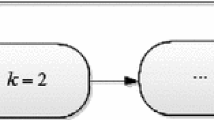Abstract
We present three new formulations for the setup assembly line balancing and scheduling problem (SUALBSP). Unlike the simple assembly line balancing problem, sequence-dependent setup times are considered between the tasks in the SUALBSP. These setup times may significantly influence the station times. Thus, there is a need for scheduling the list of tasks within each station so as to optimize the overall performance of the assembly line. In this study, we first scrutinize the previous formulation of the problem, which is a station-based model. Then, three new formulations are developed by the use of new sets of decision variables. In one of these formulations, the schedule-based formulation, SUALBSP is completely formulated as a scheduling problem. That is, no decision variable in the model directly denotes a station. All the proposed formulations will be improved by the use of several enhancement techniques such as preprocessing and valid inequalities. These improved formulations can be applied to establishing lower bounds on the problem. To assess the performance of new formulations, results of an extensive computational study on the benchmark data sets are also reported.


Similar content being viewed by others
References
Andrés C, Miralles C, Pastor R (2008) Balancing and scheduling tasks in assembly lines with sequence-dependent setup times. Eur J Oper Res 187(3):1212–1223
Battaïa O, Dolgui A (2013) A taxonomy of line balancing problems and their solutionapproaches. Int J Prod Econ 142(2):259–277 (anticipation of risks impacts and industrial performance evaluation in distributed organizations life cycles)
Baybars İ (1986) A survey of exact algorithms for the simple assembly line balancing problem. Manag Sci 32(8):909–932
Becker C, Scholl A (2009) Balancing assembly lines with variable parallel workplaces: problem definition and effective solution procedure. Eur J Oper Res 199(2):359–374
Bowman EH (1960) Assembly-line balancing by linear programming. Oper Res 8(3):385–389
Dolgui A, Kovalev S, Kovalyov MY, Nossack J, Pesch E (2014) Minimizing setup costs in a transfer line design problem with sequential operation processing. Int J Prod Econ 151:186–194
Erel E, Sarin SC (1998) A survey of the assembly line balancing procedures. Prod Plan Control 9(5):414–434
Esmaeilbeigi R, Charkhgard P, Charkhgard H (2015a) Order acceptance and scheduling problems in two-machine flow shops: new mixed integer programming formulations. Eur J Oper Res 000:1–13. doi:10.1016/j.ejor.2015.11.036
Esmaeilbeigi R, Naderi B, Charkhgard P (2015b) The type e simple assembly line balancing problem: a mixed integer linear programming formulation. Comput Oper Res 64:168–177
Kucukkoc I, Zhang DZ (2015) Balancing of parallel u-shaped assembly lines. Comput Oper Res 64:233–244
Martino L, Pastor R (2010) Heuristic procedures for solving the general assembly line balancing problem with setups. Int J Prod Res 48(6):1787–1804
Pape T (2015) Heuristics and lower bounds for the simple assembly line balancing problem type 1: overview, computational tests and improvements. Eur J Oper Res 240(1):32–42
Pastor R, Ferrer L (2009) An improved mathematical program to solve the simple assembly line balancing problem. Int J Prod Res 47(11):2943–2959
Patterson JH, Albracht JJ (1975) Technical noteassembly-line balancing: Zero-one programming with fibonacci search. Oper Res 23(1):166–172
Scholl A, Boysen N, Fliedner M (2008) The sequence-dependent assembly line balancing problem. OR Spectr 30(3):579–609
Scholl A, Boysen N, Fliedner M (2013) The assembly line balancing and scheduling problem with sequence-dependent setup times: problem extension, model formulation and efficient heuristics. OR Spectr 35(1):291–320
Scholl A, Fliedner M, Boysen N (2010) Absalom: Balancing assembly lines with assignment restrictions. Eur J Oper Res 200(3):688–701
Sewell EC, Jacobson SH (2012) A branch, bound, and remember algorithm for the simple assembly line balancing problem. INFORMS J Comput 24(3):433–442
White WW (1961) Letter to the editorcomments on a paper by bowman. Oper Res 9(2):274–276
Yolmeh A, Kianfar F (2012) An efficient hybrid genetic algorithm to solve assembly line balancing problem with sequence-dependent setup times. Comput Ind Eng 62(4):936–945
Author information
Authors and Affiliations
Corresponding author
Appendix
Appendix
1.1 The secondary objective
Scholl et al. (2013) consider the objective function (76) and constraint sets (77) and (78) to embed a secondary objective into their formulation.
In this model, \(T_k\) is a continuous variable representing the station time for station k. In addition, \(\varepsilon \) is a sufficiently small number, i.e., \(\varepsilon =1/(c\cdot (n+1))\). The secondary objective minimizes the total setup time by minimizing the sum of the station times. Constraint set (77) in conjunction with the objective function (76) captures the station time of station k. Constraint set (78) states non-negativity of the variables \(T_k\). As is seen, including the secondary objective (76) requires addition of \(O(n^2)\) disjunctive constraints.
One other way to incorporate the secondary objective into the formulation is to use the following objective function and constraints:
According to this model, if task i is the last task in its station, then variable \(T'_i\) gets the value of the station time of that station to which task i is assigned, and zero otherwise. This method requires only n additional constraints.
Still, the secondary objective can be included into the formulation more effectively. Let idle time be defined as the difference between the cycle time and the station time. If I be the total idle time, and S be the total setup time, the relation \(S+I+t_\mathrm{sum}=m \cdot c\) holds. So, for a given value of the line capacity, maximization of the total idle time is equivalent to minimization of the total setup time. Thus, the following scheme is proposed.
The objective function (82) minimizes the number of stations as the primary objective and the total setup time as the secondary objective. Because \(z_n\) takes an integer value and \(I \in [0,\bar{m}\cdot c-t_\mathrm{sum}]\), maximization of the total idle time (minimization of the total setup time) has no effect on optimization of the primary objective. This approach just needs one additional constraint.
Rights and permissions
About this article
Cite this article
Esmaeilbeigi, R., Naderi, B. & Charkhgard, P. New formulations for the setup assembly line balancing and scheduling problem. OR Spectrum 38, 493–518 (2016). https://doi.org/10.1007/s00291-016-0433-3
Received:
Accepted:
Published:
Issue Date:
DOI: https://doi.org/10.1007/s00291-016-0433-3




